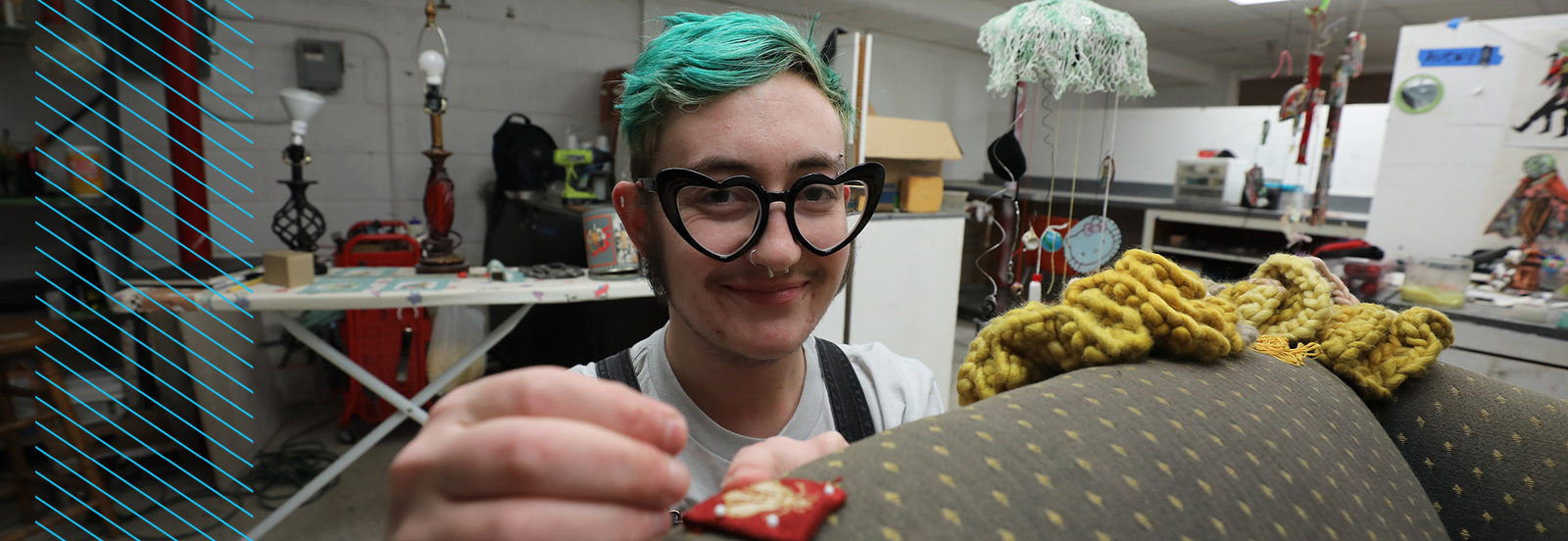
Art - Studio Arts, B.F.A.
Studio arts are about exploring and experimenting with different artistic media to create meaningful and engaging works of art. It requires a deep understanding of art principles, as well as an ability to effectively communicate ideas and emotions through the use of color, texture, form, and other design elements.
Overview
In the studio arts concentration, students focus on developing their artistic skills, exploring various media, and cultivating their creative expression. Through a combination of hands-on studio work, art history courses, and critical feedback, students focus on honing their artistic skills, expanding their artistic vocabulary, and deepening their understanding of the art world.
At the core of the program, students engage in intensive studio practice, devoting significant time to creating art in their chosen media. They experiment with different materials, techniques, and processes, allowing them to develop proficiency and fluency in their artistic practice. Whether it's painting, sculpture, printmaking, ceramics, or other media, students explore the technical aspects and conceptual foundations of their craft.
Alongside studio practice, students also delve into art history courses. They study the works of influential artists, art movements, and cultural contexts that have shaped the art world. This knowledge provides them with a historical and theoretical framework to inform their own artistic practice and critical thinking.
Critiques and discussions play a vital role in the program. Students participate in group critiques where they present their artwork and receive constructive feedback from faculty and peers. These critiques foster an environment of collaboration, dialogue, and growth, helping students refine their artistic vision, address conceptual challenges, and experiment with new ideas.
The interdisciplinary nature of a studio arts program encourages students to explore connections between different artistic disciplines and approaches. They have opportunities to engage in cross-disciplinary projects, collaborate with students from other creative fields, or experiment with new media outside their primary focus. This interdisciplinary approach nurtures a spirit of exploration, innovation, and artistic risk-taking.
Throughout the program, students work on developing their artistic voice and vision. They are encouraged to explore personal themes, conceptual frameworks, and individual narratives in their work. This process involves self-reflection, research, and experimentation to deepen their understanding of their own artistic practice and its relevance in contemporary art discourse.
In addition to their studio practice and coursework, students have the chance to exhibit their work in student shows or participate in external exhibitions, which allows them to gain exposure and build a professional portfolio. They also benefit from visiting artists, workshops, and other events that provide insights into the professional art world and connect them with practicing artists.
The program culminates in a capstone project and final exhibition that showcases students' artistic growth, technical proficiency, and conceptual development. This exhibition serves as a platform to launch their professional careers as practicing artists, pursue further studies, or explore opportunities within the field.
Curriculum and Concentration Requirements
Please review the official academic catalog for comprehensive information on requirements.
Careers
Concentrating in studio arts opens a wide range of careers in the arts and creative industries. Possible career paths for students concentrating in studio arts:
- Fine Artist: Fine artists create original works of art, such as paintings, sculptures, and installations, and exhibit their work in galleries and museums. They use their artistic skills and vision to create unique and engaging works of art.
- Art Director: Art directors work in advertising, publishing, and other media industries to oversee the visual elements of a project, including graphics, images, and layout. They use their knowledge of design principles and project management to ensure that the final product meets the client's needs and goals.
- Illustrator: Illustrators create visual representations of ideas, concepts, and stories for books, magazines, advertisements, and other media. They use their artistic skills and knowledge of design principles to create engaging and informative images.
- Art Conservator: Art conservators work in museums, galleries, and other cultural institutions to preserve and restore works of art. They use their knowledge of conservation techniques and materials to protect and maintain art for future generations.
- Art Gallery Manager: Art gallery managers oversee the day-to-day operations of an art gallery, including managing staff, maintaining inventory, and creating sales strategies. They use their knowledge of art history, art market trends, and business operations to create a successful and profitable gallery.
Depending on students’ interests and skills, their artistic skills and knowledge of design principles can be applied in many different ways.

